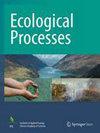螺旋藻(Vallisneria spiralis L.)的适应能力可改善有机污染沉积物中的孔隙水化学性质并提高硝化潜力
IF 3.9
2区 环境科学与生态学
Q1 ECOLOGY
引用次数: 0
摘要
通过根部的径向氧气损失,大型营养体可改变底栖生物多样性和生物地球化学。这种情况与沉积物缺氧形成鲜明对比,允许根系呼吸,有利于根瘤菌圈中好氧微生物群落和过程。与此同时,根圈可通过渗出物或有利于电子受体(如硝酸盐)的积累来刺激厌氧微生物和过程。由于富营养化通常会导致沉积物中的有机物富集和大量内部养分循环,因此一个有趣的研究问题是,植物是否也能在有机污染加剧的情况下保持刺激好氧或厌氧微生物群落和过程的能力。我们在实验室控制条件下进行了一项操纵实验。实验创建了包含裸露沉积物和移植了大型植物螺旋藻(Vallisneria spiralis L.)的沉积物的微型生态系统。在经过 30 天的适应期后,研究了该植物对有机物含量中等(8%)和较高(21%)的沉积物的影响。适应期结束后,在两个不同深度(0-1 厘米和 1-5 厘米)测量了化学和物理参数、微生物群落组成以及硝化、反硝化和硝酸盐氨化的潜在速率,以评估根的作用。螺旋藻在两种有机物质水平下都能生长并同化孔隙水养分,与裸露沉积物相比,植被沉积物的孔隙水总是营养贫乏的。与反硝化细菌相比,硝化微生物的相对丰度和多样性较低。然而,无论有机物含量如何,与裸露沉积物相比,在植被沉积物的较深地层都能检测到硝化微生物,而在裸露沉积物中,硝化作用仅限于地表附近。相比之下,潜在反硝化率不受根系存在的影响,但可能受硝酸盐存在和根系依赖性硝化作用的调节。潜在硝酸盐氨化率总是比潜在反硝化率低很多(< 3%)。在有机物含量适中和较高的情况下,螺旋藻会影响与氮有关的微生物多样性和生物地球化学,使底层水-孔隙水的化学梯度变得平缓,刺激硝化作用和通过反硝化作用造成的氮损失。这些结果表明,在受高有机物负荷影响的淡水系统(如污水处理厂下游)中,可以将螺旋藻作为一种基于自然的解决方案来应对富营养化。本文章由计算机程序翻译,如有差异,请以英文原文为准。
Vallisneria spiralis L. adaptive capacity improves pore water chemistry and increases potential nitrification in organic polluted sediments
Macrophytes may modify benthic biodiversity and biogeochemistry via radial oxygen loss from roots. This condition contrasts sediments anoxia, allows roots respiration, and facilitates aerobic microbial communities and processes in the rhizosphere. Simultaneously, the rhizosphere can stimulate anaerobic microorganisms and processes via exudates or by favoring the build-up of electron acceptors as nitrate. As eutrophication often results in organic enrichment in sediments and large internal nutrients recycling, an interesting research question is to investigate whether plants maintain the capacity to stimulate aerobic or anaerobic microbial communities and processes also under elevated organic pollution. A manipulative experiment was carried out under laboratory-controlled conditions. Microcosms containing bare sediments and sediments transplanted with the macrophyte Vallisneria spiralis L. were created. The effect of the plant was investigated on sediments with moderate (8%) and elevated (21%) organic matter content, after an acclimatization period of 30 days. Chemical and physical parameters, microbial community composition and the potential rates of nitrification, denitrification and nitrate ammonification were measured at two different depths (0–1 and 1–5 cm) after the acclimatization period to evaluate the role of roots. Vallisneria spiralis grew and assimilated pore water nutrients at the two organic matter levels and vegetated sediments had always nutrient-depleted porewaters as compared to bare sediments. Nitrifying microbes had a lower relative abundance and diversity compared to denitrifying bacteria. However, regardless of the organic content, in vegetated sediments nitrifiers were detected in deeper horizons as compared to bare sediments, where nitrification was confined near the surface. In contrast, potential denitrification rates were not affected by the presence of roots, but probably regulated by the presence of nitrate and by root-dependent nitrification. Potential nitrate ammonification rates were always much lower (< 3%) than potential denitrification rates. Vallisneria spiralis affects N-related microbial diversity and biogeochemistry at moderate and elevated organic matter content, smoothing bottom water–pore water chemical gradients and stimulating nitrification and nitrogen loss via denitrification. These results suggest the possibility to deploy V. spiralis as a nature-based solution to counteract eutrophication in freshwater systems impacted by high loads of organic matter, for example, downstream of wastewater treatment plants.
求助全文
通过发布文献求助,成功后即可免费获取论文全文。
去求助
来源期刊

Ecological Processes
Environmental Science-Ecological Modeling
CiteScore
8.50
自引率
4.20%
发文量
64
审稿时长
13 weeks
期刊介绍:
Ecological Processes is an international, peer-reviewed, open access journal devoted to quality publications in ecological studies with a focus on the underlying processes responsible for the dynamics and functions of ecological systems at multiple spatial and temporal scales. The journal welcomes manuscripts on techniques, approaches, concepts, models, reviews, syntheses, short communications and applied research for advancing our knowledge and capability toward sustainability of ecosystems and the environment. Integrations of ecological and socio-economic processes are strongly encouraged.
 求助内容:
求助内容: 应助结果提醒方式:
应助结果提醒方式:


